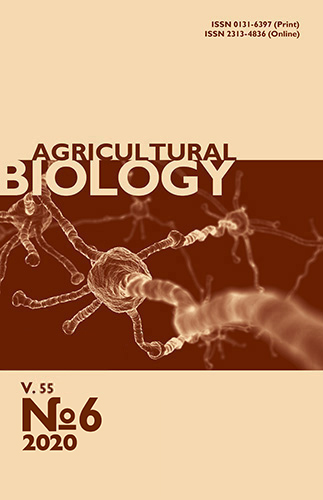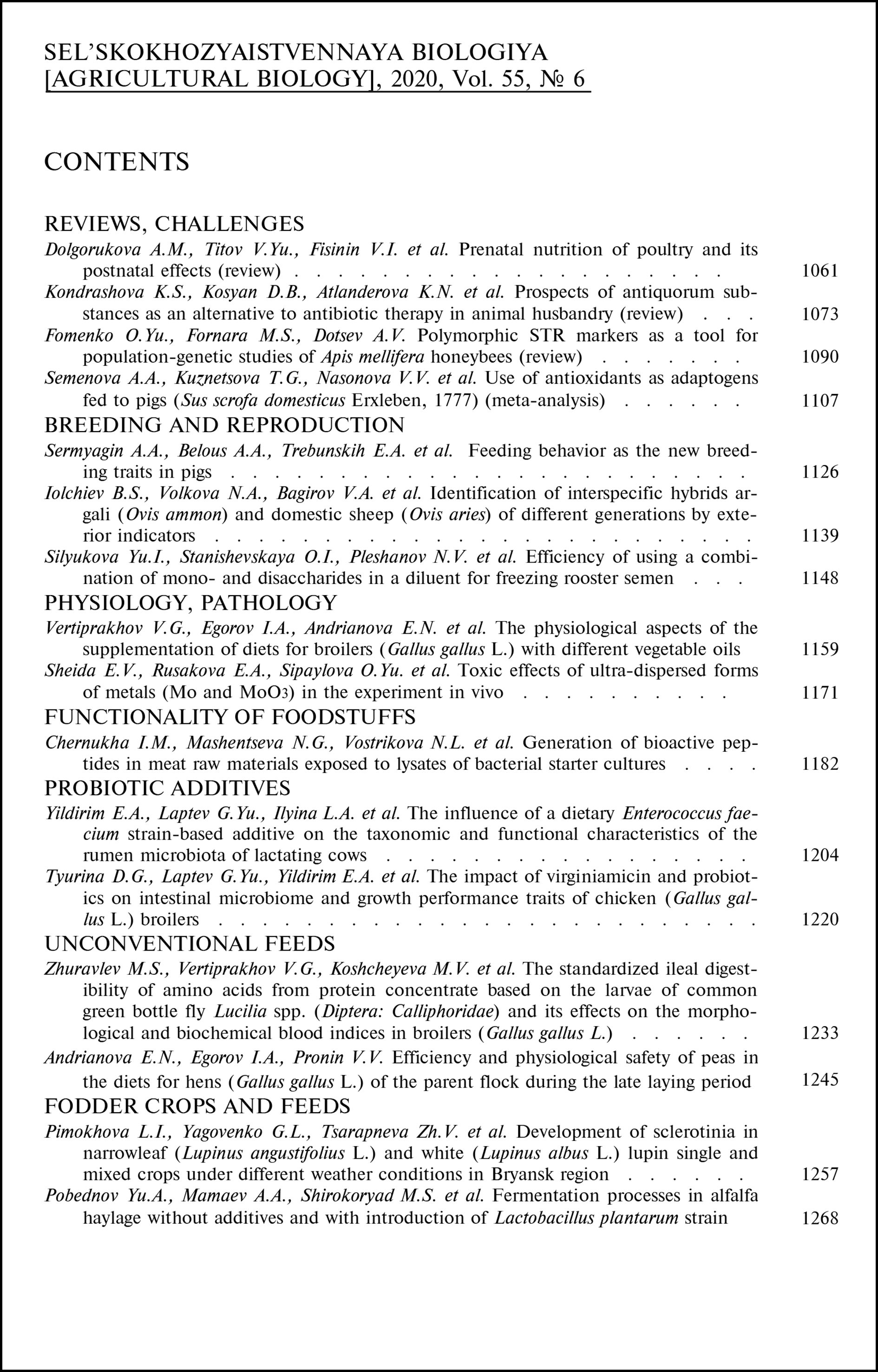doi: 10.15389/agrobiology.2020.6.1148eng
UDC: 636.5:591.16:611.013.11:57.04
Acknowledgements:
Research conducted on the topic AAAA-A18-118021590132-9.
EFFICIENCY OF USING A COMBINATION OF MONO- AND DISAC-CHARIDES IN A DILUENT FOR FREEZING ROOSTER SEMEN
Yu.I. Silyukova, O.I. Stanishevskaya, N.V. Pleshanov,
A.A. Kurochkin
All-Russian Research Institute for Farm Animal Genetics and Breeding — Branch of Ernst Federal Science Center for Animal Husbandry, 55А, Moskovskoe sh., pos. Tyarlevo, St. Petersburg—Pushkin, 196625 Russia, e-mail svadim33@mail.ru (✉ corresponding author), olgastan@list.ru, Klaus-90@list.ru, kurochkin.anton66@gmail.com
ORCID:
Silyukova Yu.L. orcid.org/0000-0003-1905-6373
Pleshanov N.V. orcid.org/0000-0002-4634-7515
Stanishevskaya O.I. orcid.org/0000-0001-9504-3916
Kurochkin A.A. orcid.org/0000-0003-3171-8499
Received September 10, 2020
Different combination of saccharides can provide better semen protection during freezing/thawing cycle. Until now, the disaccharide maltose has not been used as a component of the medium for cryopreservation roosters’ semen. Since maltose is not involved in carbohydrate metabolism of spermatozoa, there is an assumption about its role in strengthening the structure of the glycocalyx, which is a progressive evolutionary cellular structure that regulates specific cellular adaptations to a certain temperature, chemical and other paratypical effects. In this work, in order to increase the fertility of frozen/thawed semen, we tested a combination of saccharides in the diluent for cryopreservation of roosters’ semen. For the first time, maltose has been proven to be effective in combination with fructose in a diluent to increase the fertility of frozen/thawed roosters’ semen. The aim of the study was to determine the optimal concentration of the test component of maltose based on the diluent of the Leningrad Cryoprotective Medium (LCM) (1984) for freezing the semen of roosters and determining the time of maintaining the functional usefulness of frozen/thawed cock semen in the genital tract of the hen. The experiment was carried out in the Center for Collective Use Genetic collection of rare and endangered chicken breeds (the Russian Research Institute of Farm Animal Genetics and Breeding, 2020) on a breed of Russian white chickens (♂n = 10, ♀n = 30) at the age of 46-50 weeks. Three variants of media for cryopreservation of roosters’ semen with different ratios of saccharides were evaluated. In each group, the Mal-10 (fructose 0.72 %, maltose 0.166 %), Mal-20 (fructose 0.64 %, maltose 0.326 %) and LCS-control (fructose 0.8 %, maltose 0 %), there were 10 hens for insemination. The results show not only an increase in the total percentage of fertilized eggs when using frozen/thawed semen in the Mal-10 (92.6 %) and Mal-20 (86.3 %) groups compared to the LKS-control group (74.7 %), but also an increase in the duration of the functional usefulness of spermatozoa in the genital tract of hen within 5 days at the level of native sperm. Counting the points of interaction of spermatozoa with the perivitelline membrane of the yolk 5 days after the last insemination showed that the functional ability of spermatozoa is much higher when using experimental media containing maltose, 67.0 pcs/cm2 for Mal-10 and 110.7 pcs/cm2 for Mal-20 vs. 40.1 pcs/cm2 in maltose-free LKS-control. The longest duration of the functional usefulness of spermatozoa was noted in the Mal-20 group. Even on day 15 after the last insemination, the fertilization capacity of frozen/thawed semen was recorded at the level of 20 %. A regression equation was drawn up for the relationship of egg fertilization with the points of interaction of spermatozoa with the perivitelline membrane of the yolk. To obtain an egg fertilization level of ≥ 80 %, the functional usefulness of frozen-thawed spermatozoa (expressed through the number of points of interaction with the perivitelline membrane of the yolk) should be ≥ 60 pcs/cm2. This was achieved by using an experimental diluent with 0.326 % maltose. The results obtained open up the possibility of using cryopreserved semen not only in preserving the gene pool, but also in breeding programs.
Keywords: roosters, semen, fertility, cryopreservation, media, maltose, perivitelline membrane.
REFERENCES
- Thélie A., Bailliard A., Seigneurin F., Zerjal T., Tixier-Boichard M., Blesbois E. Chicken semen cryopreservation and use for the restoration of rare genetic resources. Poultry Science, 2018, 98(1): 447-455 CrossRef
- Silyukova Yu., Stanishevskaya O., Dement'eva N. Vavilovskii zhurnal genetiki i selektsii, 2020, 24(2): 176-184 CrossRef (in Russ.).
- Di Iorio M., Rusco G., Iampietro R., Colonna M.A., Zaniboni L., Cerolini S., Iaffaldano N. Finding an effective freezing protocol for turkey semen: benefits of ficoll as non-permeant cryoprotectant and 1:4 as dilution rate. Animals, 2020, 10(3): 421 CrossRef
- Peláez J., Long J.A. Characterizing the glycocalyx of poultry spermatozoa: II. In vitro storage of Turkey semen and mobility phenotype affects the carbohydrate component of sperm membrane glycoconjugates. Journal of Andrology,2008, 29(4): 431‐439 CrossRef
- Salehi M., Mahdavi A.H., Sharafi M., Shahverdi A. Cryopreservation of rooster semen: evidence for the epigenetic modifications of thawed sperm. Theriogenology, 2020, 142: 15-25 CrossRef
- Silyukova Y., Pleshanov N., Stanishevskaya O. The influence membranes damage and activity of roosters’ sperm on the fertilization of eggs when using cured cryopreserved sperm. Reproduction in Domestic Animals, 2019, 54(S3): 101 CrossRef
- Partyka A., Łukaszewicz E., Niżański W. Flow cytometric assessment of fresh and frozen-thawed Canada goose (Branta canadensis) semen. Theriogenology, 2011, 76(5): 843-850 CrossRef
- Huebinger J., Han H.-M., Hofnagel O., Vetter I.R., Bastiaens P.I.H., Grabenbauer M. Direct measurement of water states in cryopreserved cells reveals tolerance toward ice crystallization. Biophysical Journal, 2016, 110(4): 840-849 CrossRef
- Askarianzadeh Z., Sharafi M., Torshizi M.A.K. Sperm quality characteristics and fertilization capacity after cryopreservation of rooster semen in extender exposed to a magnetic field. Animal Reproduction Science, 2018, 198: 37‐46 CrossRef
- Zaniboni L., Cassinelli C., Mangiagalli M.G., Gliozzi T.M., Cerolini S. Pellet cryopreservation for chicken semen: effects of sperm working concentration, cryoprotectant concentration, and equilibration time during in vitro processing. Theriogenology, 2014, 82(2): 251-258 CrossRef
- Fattah A., Sharafi M., Masoudi R., Shahverdi A., Esmaeili V., Najafi A. L-Carnitine in rooster semen cryopreservation: flow cytometric, biochemical and motion findings for frozen-thawed sperm. Cryobiology, 2017, 74: 148‐153 CrossRef
- Amini M.R., Kohram H., Zare-Shahaneh A., Zhandi M., Sharideh H., Nabi M.M. The effects of different levels of catalase and superoxide dismutase in modified Beltsville extender on rooster post-thawed sperm quality. Cryobiology,2015, 70(3): 226‐232 CrossRef
- Najafi A., Taheri R.A., Mehdipour M., Farnoosh G., Martínez-Pastor F. Lycopene-loaded nanoliposomes improve the performance of a modified Beltsville extender broiler breeder roosters. Animal Reproduction Science, 2018, 195: 168-175 CrossRef
- Thananurak P., Chuaychu-noo N., Thélie A., Phasuk Y., Vongpralub T., Blesbois E. Different concentrations of cysteamine, ergothioneine, and serine modulate quality and fertilizing ability of cryopreserved chicken sperm. Poultry Science, 2020, 99(2): 1185-1198 CrossRef
- Thananurak P., Chuaychu-Noo N., Thélie A., Phasuk Y., Vongpralub T., Blesbois E. Sucrose increases the quality and fertilizing ability of cryopreserved chicken sperms in contrast to raffinose. Poultry Science, 2019, 98(9): 4161‐4171 CrossRef
- Lotfi S., Mehri M., Sharafi M., Masoudi R. Hyaluronic acid improves frozen-thawed sperm quality and fertility potential in rooster. Animal Reproduction Science, 2017, 184: 204‐210 CrossRef
- Donoghue A.M., Wishart G.J. Storage of poultry semen. Animal Reproduction Science, 2000, 62(1-3): 213-232 CrossRef
- Mavrodina T., Stanishevskaya O., Cherepanov S., Silyukova Y. Influence of osmolality of the media for dilution and cryopreservation of turkey toms’ sperm on fertilization ability of thawed sperm. Reproduction in Domestic Animals, 2018, 53(Suppl. 2): 164.
- Gloria A., Toscani T., Robbe D., Parrillo S., De Amicis I., Contri A. Cryopreservation of turkey spermatozoa without permeant cryoprotectants. Animal Reproduction Science, 2019, 211: 106-218 CrossRef
- Shahverdi A., Sharafi M., Gourabi H., Yekta A.A., Esmaeili V., Sharbatoghli M., Janzamin E., Hajnasrollahi M., Mostafayi F. Fertility and flow cytometric evaluations of frozen-thawed rooster semen in cryopreservation medium containing low-density lipoprotein. Theriogenology, 2015, 83(1): 78-85 CrossRef
- Mosca F., Madeddu M., Sayed A.A., Zaniboni L., Iaffaldano N., Cerolini S. Data on the positive synergic action of dimethylacetamide and trehalose on quality of cryopreserved chicken sperm. Data in Brief, 2019, 9: 1118‐1121 CrossRef
- Menezes G.F.O., Bittencourt R.F., Ribeiro Filho A.L., Cardoso F.L., Silva M.A.A., Santos E.S. Dimetilacetamida associada ou não ao glicerol para criopreservação de sêmen ovino [Dimethylacetamide associated or not to glycerol for criopreservation of sheep semen]. Ciência Animal Brasileir, 2018, 19: e-48026 CrossRef
- Xi M.D., Li P., Du H., Qiao X.M., Liu Z.G., Wei Q.W. Disaccharide combinations and the expression of enolase3 and plasma membrane Ca2+ ATPase isoform in sturgeon sperm cryopreservation. Reproduction in Domestic Animals, 2018, 53(2): 472-483 CrossRef
- Yildiz C., Kaya A., Aksoy M., Tekeli T. Influence of sugar supplementation of the extender on motility, viability and acrosomal integrity of dog spermatozoa during freezing. Theriogenology, 2000, 54(4): 579-585 CrossRef
- Golshahi K., Aramli M.S., Nazari R.M., Habibi H. Disaccharide supplementation of extenders is an effective means of improving the cryopreservation of semen in sturgeon. Aquaculture, 2018, 486: 261-265 CrossRef
- Khiabani A.B., Moghaddam G., Kia H.D. Effects of adding different levels of glutamine to modified Beltsville extender on the survival of frozen rooster semen. Animal Reproduction Science, 2017, 184: 172-177 CrossRef
- Burrows W.A., Quinn J. P. A method of obtaining spermatozoa from the domestic fowl. Poultry Science, 1935, 14(4): 251-254.
- Tselyutin K.V., Tur B.K. Iskusstvennoe osemenenie i kriokonservatsiya spermy sel'skokhozyaistvennoi ptitsy (petukhi, indyuki, gusaki, selezni) [Artificial insemination and cryopreservation of poultry sperm (roosters, turkeys, geese, drakes)]. St. Petersburg—Pushkin, 2013 (in Russ.).
- Popov I.I. Voprosy iskusstvennogo osemeneniya domashnikh ptits [Artificial insemination of poultry]. St. Petersburg—Pushkin, 2000 (in Russ.).
- Bakst M., Eastridge J., Malecki I. The inner perivitelline layer sperm hole assay: use of filter paper rings for the isolation of the perivitelline layer overlying the germinal disc and new observations on its morphology. Journal of Applied Poultry Research, 2014, 23(1): 121-128 CrossRef
- Pleshanov N., Stanishevskaya O. Evaluation of the cocks spermatozoa membranes’ damaging during cryopreservation with use of Sperm VitalStain colorant. Reproduction in Domestic Animals, 2018, 53(S2): 183.
- Tecle E., Gagneux P. Sugar-coated sperm: unraveling the functions of the mammalian sperm glycocalyx. Mol. Reprod. Dev., 2015, 82(9): 635-650 CrossRef
- Long J.A. Avian semen cryopreservation: what are the biological challenges? Poultry Science, 2006, 85(2): 232-236 CrossRef
- Ponglowhapan S., Essén-Gustavsson B., Forsberg C.L. Influence of glucose and fructose in the extender during long-term storage of chilled canine semen. Theriogenology, 2004, 62(8): 1498-1517 CrossRef
- Okano T., Murase T., Yayota C., Komatsu T., Miyazawa K., Asano M., Tsubota T. Characteristics of captive Japanese black bears (Ursus thibetanus japonicus) semen collected by electroejaculation with different voltages for stimulation and frozen-thawed under different conditions. Animal Reproduction Science, 2006, 95(1-2): 134-143 CrossRef
- Naing S.W., Wahid H., Mohd Azam K., Rosnina Y., Zuki A.B., Kazhal S., Bukar M.M., Thein M., Kyaw T., San M.M. Effect of sugars on characteristics of Boer goat semen after cryopreservation. Animal Reproduction Science,2010, 122(1-2): 23-28 CrossRef
- Rakha B.A., Ansari M.S., Akhter S., Akhter A., Blesbois E., Santiago-Moreno O. Effect of dimethylformamide on sperm quality and fertilizing ability of Indian red jungle fowl (Gallus gallus murghi). Theriogenology, 2020, 149: 55-61 CrossRef
- Feofilova E.P., Usov A.I., Mysyakina I.S., Kochkina G.A. Mikrobiologiya, 2014, 83(3): 271-283 CrossRef (in Russ.).
- Ganatsios V., Koutinas A.A., Bekatorou A., Kanellaki M., Nigam P. Promotion of maltose fermentation at extremely low temperatures using a cryotolerant Saccharomyces cerevisiae strain immobilized on porous cellulosic material. Enzyme and Microbial Technology, 2014, 66: 56-59 CrossRef
- Golshahi K., Aramli M.S., Nazari R.M., Habibi E. Disaccharide supplementation of extenders is an effective means of improving the cryopreservation of semen in sturgeon. Aquaculture,2018, 486: 261-265 CrossRef
- Harris C.C., Wilcox F.H. The carbohydrate metabolism of chicken semen. Poultry Science, 1962, 41(2): 409-416 CrossRef












